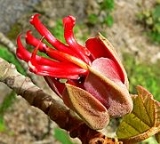
Chiranthodendron
Encyclopedia
Chiranthodendron is a genus
of flowering plant
s in the family Malvaceae
, comprising a single species of tree, Chiranthodendron pentadactylon, is called the Devil's hand tree, monkey's hand tree, or Mexican hand tree, or some variant thereof - for the distinct shape of its flowers, which resemble an open human hand
.
and southern Mexico
. The unusual appearance of the 'hands' has stimulated cultivation in gardens around the world, primarily in North America
where it grows well near its native range. The leaves are large and shallowly lobed, with a brown indumentum
on the underside. The distinctive flowers appear in late spring and early summer; the five stamens are long, curved upward, and bright red, giving the distinct impression of a clawed hand.
It was originally described from a single cultivated specimen grown in Toluca
in the Toluca Valley
, well outside the native range. The Aztecs revered the tree, and picked every bloom annually to prevent it from reproducing.
Genus
In biology, a genus is a low-level taxonomic rank used in the biological classification of living and fossil organisms, which is an example of definition by genus and differentia...
of flowering plant
Flowering plant
The flowering plants , also known as Angiospermae or Magnoliophyta, are the most diverse group of land plants. Angiosperms are seed-producing plants like the gymnosperms and can be distinguished from the gymnosperms by a series of synapomorphies...
s in the family Malvaceae
Malvaceae
Malvaceae, or the mallow family, is a family of flowering plants containing over 200 genera with close to 2,300 species. Judd & al. Well known members of this family include okra, jute and cacao...
, comprising a single species of tree, Chiranthodendron pentadactylon, is called the Devil's hand tree, monkey's hand tree, or Mexican hand tree, or some variant thereof - for the distinct shape of its flowers, which resemble an open human hand
Hand
A hand is a prehensile, multi-fingered extremity located at the end of an arm or forelimb of primates such as humans, chimpanzees, monkeys, and lemurs...
.
Description
This species is native to GuatemalaGuatemala
Guatemala is a country in Central America bordered by Mexico to the north and west, the Pacific Ocean to the southwest, Belize to the northeast, the Caribbean to the east, and Honduras and El Salvador to the southeast...
and southern Mexico
Mexico
The United Mexican States , commonly known as Mexico , is a federal constitutional republic in North America. It is bordered on the north by the United States; on the south and west by the Pacific Ocean; on the southeast by Guatemala, Belize, and the Caribbean Sea; and on the east by the Gulf of...
. The unusual appearance of the 'hands' has stimulated cultivation in gardens around the world, primarily in North America
North America
North America is a continent wholly within the Northern Hemisphere and almost wholly within the Western Hemisphere. It is also considered a northern subcontinent of the Americas...
where it grows well near its native range. The leaves are large and shallowly lobed, with a brown indumentum
Indumentum
The indumentum is a covering of fine hairs or bristles on a plant or insect.In plants, the indumentum types are:*pubescent*hirsute*pilose*villous*tomentose*stellate*scabrous*scurfy...
on the underside. The distinctive flowers appear in late spring and early summer; the five stamens are long, curved upward, and bright red, giving the distinct impression of a clawed hand.
It was originally described from a single cultivated specimen grown in Toluca
Toluca
Toluca, formally known as Toluca de Lerdo, is the state capital of Mexico State as well as the seat of the Municipality of Toluca. It is the center of a rapidly growing urban area, now the fifth largest in Mexico. It is located west-southwest of Mexico City and only about 40 minutes by car to the...
in the Toluca Valley
Toluca Valley
Toluca Valley is a valley located approximately 75 km southwest Mexico City. The modern city of Toluca is located there. Other municipalities within valley and part of the Toluca metropolitan area include Metepec, Calimaya, Almoloya de Juárez, San Mateo Atenco, Lerma, Lago, Temoaya, Otzolotepec and...
, well outside the native range. The Aztecs revered the tree, and picked every bloom annually to prevent it from reproducing.

